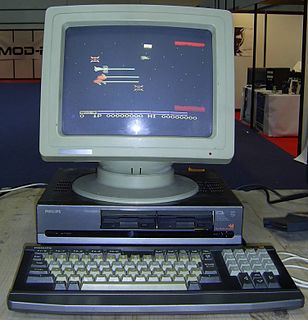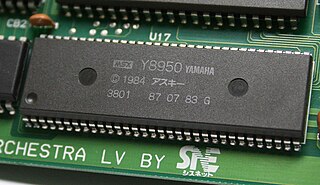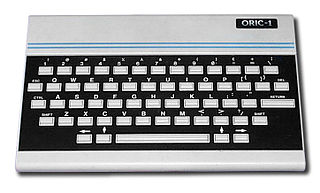
The Amstrad CPC is a series of 8-bit home computers produced by Amstrad between 1984 and 1990. It was designed to compete in the mid-1980s home computer market dominated by the Commodore 64 and the Sinclair ZX Spectrum, where it successfully established itself primarily in the United Kingdom, France, Spain, and the German-speaking parts of Europe.

The Tandy 1000 is the first in a line of IBM PC compatible home computer systems produced by the Tandy Corporation for sale in its Radio Shack and Radio Shack Computer Center chains of stores.

MSX is a standardized home computer architecture, announced by Microsoft and ASCII Corporation on June 16, 1983. It was initially conceived by Microsoft as a product for the Eastern sector, and jointly marketed by Kazuhiko Nishi, then vice-president at Microsoft and director at ASCII Corporation. Microsoft and Nishi conceived the project as an attempt to create unified standards among various home computing system manufacturers of the period, in the same fashion as the VHS standard for home video tape machines.

The SAM Coupé is an 8-bit British home computer that was first released in late 1989. It was based on and designed to have compatibility with the Sinclair ZX Spectrum 48K and marketed as a logical upgrade from the Spectrum. It was originally manufactured by Miles Gordon Technology (MGT), based in Swansea in the United Kingdom.

The X68000 is a home computer created by Sharp Corporation. It was first released in 1987 and sold only in Japan. Gaming was a major use of the X68000, with custom sprite hardware and an 8-channel sound chip enabling ports of contemporaneous arcade video games.

The FM Towns is a Japanese personal computer, built by Fujitsu from February 1989 to the summer of 1997. It started as a proprietary PC variant intended for multimedia applications and PC games, but later became more compatible with IBM PC compatibles. In 1993, the FM Towns Marty was released, a game console compatible with existing FM Towns games.

The Power Macintosh 6100 is a personal computer designed, manufactured and sold by Apple Computer, Inc. from March 1994 to March 1996. It is the first computer from Apple to use the new PowerPC processor created by IBM and Motorola. The low-profile ("pizza-box") case was inherited from the Centris/Quadra 610 and 660AV models, and replaced the Macintosh Quadra series that used the Motorola 68040 processor, Apple's previous high-end workstation line.

The Yamaha V9938 is a video display processor (VDP) used on the MSX2 home computer, as well as on the Geneve 9640 enhanced TI-99/4A clone. It was also used in a few MSX1 computers, in a configuration with 16kB VRAM.

The Macintosh Quadra 605 is a personal computer designed, manufactured, and sold by Apple Computer, Inc. from October 1993 to July 1996. The model names reflect a decision made at Apple in 1993 to follow an emerging industry trend of naming product families for their target customers – Quadra for business, LC for education, and Performa for home. Accordingly, the Performa 475 and 476 was sold in department stores and electronics stores such as Circuit City, whereas the Quadra was purchased through an authorized Apple reseller.

The Compaq Presario 1200 was a line of notebook computers produced between 1998 and 2000 by Compaq as part of Compaq Presario line. They were originally noted for their AMD processors, light weight and 12-inch LCD screens, while later models included a shift to Intel processors and other changed features. The label of "Compaq Presario 1200" includes a vast set of model numbers and revisions, many of which are not totally compatible, even though the machines share the same general Presario model number.

The One chip MSX, or 1chipMSX as the D4 Enterprise distributional name for the ESE MSX System 3, is a re-implementation of an MSX-2 home computer that uses a single FPGA to implement all the electronics of an MSX-2, including the MSX-MUSIC and SCC+ audio extensions.

The Philips NMS-8250, was a professional MSX 2 home computer for the high end market, with two built in floppy disk drives in a "pizza box" configuration. The machine was in fact manufactured by Sanyo and it is basically the MPC-25FS with a different color.
An MSX-ENGINE chip is a specially developed integrated circuit for home computers that are built according to the MSX specifications. Generally, such a chip combines the functions of many separate, older/simpler chips into one. This is done to reduce required circuit board space, power consumption, and production costs for complete systems.

The Yamaha Y8950 is a sound chip, produced in 1984. Essentially a Yamaha YM3526 with an ADPCM encoder/decoder added on, it is also known as MSX-Audio as it was designed for inclusion in an expansion cartridge for the MSX personal computer.

Toshiba Pasopia 7 is a computer from manufacturer Toshiba, released in 1983 and only available in Japan. It was intended as the successor of the Toshiba Pasopia, offering improved sound and graphics. Graphic memory is increased to 48kb and two SN76489 sound chips are available, producing six five octave channels and two noise channels.

The Panasonic FS-A1WSX released in 1989 was the last MSX2+ made by Panasonic. It was the successor of FS-A1WX and incorporated few changes like S-Video output, no tape support, color printer support and an improved A1 Internal Cockpit software with a Kanji color word processor.

Oric was the name used by UK-based Tangerine Computer Systems for a series of 6502-based home computers sold in the 1980s, primarily in Europe.
The MZ-2500, also known as the Super MZ, is an 8-bit personal computer released on 1 October 1985 as part of the Sharp MZ series. It is a successor to the MZ-2000/2200 and a direct successor to the MZ-80B. From the previous generation, MZ-2000, it was a model that was given significant functions along with faster speed processors. It is also the final model of the entire 8-bit MZ series with its own architecture, and it is one of the models sometimes called the best 8-bit machines, along with the 6809 FM77AV and the MB-S1. In the Japanese computer magazines, it was also called the phoenix (Phoenix). Its successor is the Sharp MZ-2861, which has a compatible mode and a newly developed 16-bit mode. The development code is LEY and can be found in the circuit diagram etc.

Toshiba Pasopia is a computer from manufacturer Toshiba, released in 1981 and based around a Zilog Z80 microprocessor. This is not to be confused with the Toshiba Pasopia IQ, a similar named line of MSX compatible computers.
Toshiba Pasopia 16 or PA7020 is a IBM PC compatible computer from manufacturer Toshiba, released in 1982 and based around a Intel 8088-2 microprocessor running at 6 MHz. It's also known as T300 on the US and PAP in Europe.




















